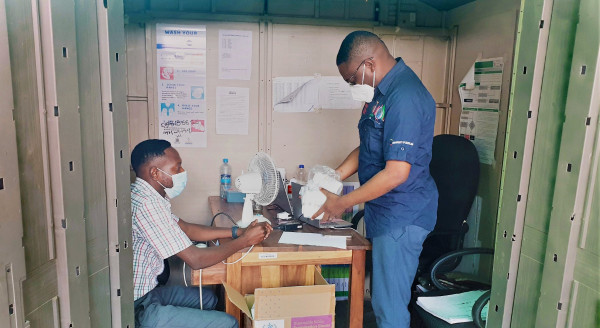
Dr Suilanji Sivile is an HIV clinician in Zambia who started working in the Eastern Province nearly a decade ago. He is also an HIV Technical Advisor at the Ministry of Health, leading many national COVID-19 activities. Reflecting on how the COVID-19 pandemic unfolded in Zambia, Dr Sivile highlights key decisions and turning points that contributed to resilient HIV service delivery. “An important decision we took early on was to roll out the new HIV guidelines together with COVID-19 guidance,” he says. As the guidance was disseminated, community concerns and misinformation were addressed. “Partnering with civil society was another key decision point and helped get the right messages out on HIV and COVID-19.”
Data played a key role in the government response to COVID-19 and identifying how to adapt HIV services. “When the country issued a partial lockdown during the first wave of COVID-19, we instantly started monitoring the data and looking for ways to keep HIV services going. Once we saw some disruption to HIV testing and other services, leadership quickly changed strategies and started integrating COVID-19 and HIV activities to open things up,” notes Dr Sivile, adding that strong leadership and partnerships were essential early on. “The government and ministry of health were able to use data to drive decision making with support from PEPFAR and WHO guidance. The partnerships helped get things under control quickly.”
Personal protective equipment (PPE) for health workers and enabling communities and lay providers to deliver services were priorities. Those doing index testing for HIV were capacitated to also follow-up patients with COVID-19 and do contact tracing. “Having PPE available, as well as a triaging system to screen patients, helped health workers feel comfortable coming to work, which was important during both the first and the subsequent waves of COVID-19 infections,” says Dr Sivile. In antenatal care, an existing weekly dashboard was instrumental in protecting HIV testing and treatment services for children and pregnant women. This was an essential service to prevent mother-to-child transmission of HIV. According to joint analysis from WHO and the Zambian Ministry of Health HIV testing and treatment initiation among pregnant women remained stable with minimal disruption throughout 2020 and the pandemic.
Zambia has led the way on many innovative programmes, such as working with correctional services programmes on HIV and COVID-19 to combat both infections. Programming led by sex-workers and truck drivers engaged in HIV activities also effectively supported the public health response to the first cluster of COVID-19 infections in northern Zambia. “Having good quality data for reaching these groups and all other populations affected by HIV and COVID-19 remains crucial,” says Dr Sivile.
WHO applauds Zambia’s Ministry of Health and all the health workers for their resilience and achievements in delivering HIV testing and treatment services in face of many challenges. Through the scale-up of testing, prevention and treatment services, the ambitious 90-90-90 targets were achieved by the end of 2020 in Zambia. As WHO launches an assessment report on the impact of COVID-19 on HIV testing services, the successes from Zambia provide key examples for countries on the way forward to sustain progress to date and for achieving the global goals.
Distributed by APO Group on behalf of World Health Organization (WHO).
© Press Release 2021
Disclaimer: The contents of this press release was provided from an external third party provider. This website is not responsible for, and does not control, such external content. This content is provided on an “as is” and “as available” basis and has not been edited in any way. Neither this website nor our affiliates guarantee the accuracy of or endorse the views or opinions expressed in this press release.
The press release is provided for informational purposes only. The content does not provide tax, legal or investment advice or opinion regarding the suitability, value or profitability of any particular security, portfolio or investment strategy. Neither this website nor our affiliates shall be liable for any errors or inaccuracies in the content, or for any actions taken by you in reliance thereon. You expressly agree that your use of the information within this article is at your sole risk.
To the fullest extent permitted by applicable law, this website, its parent company, its subsidiaries, its affiliates and the respective shareholders, directors, officers, employees, agents, advertisers, content providers and licensors will not be liable (jointly or severally) to you for any direct, indirect, consequential, special, incidental, punitive or exemplary damages, including without limitation, lost profits, lost savings and lost revenues, whether in negligence, tort, contract or any other theory of liability, even if the parties have been advised of the possibility or could have foreseen any such damages.










